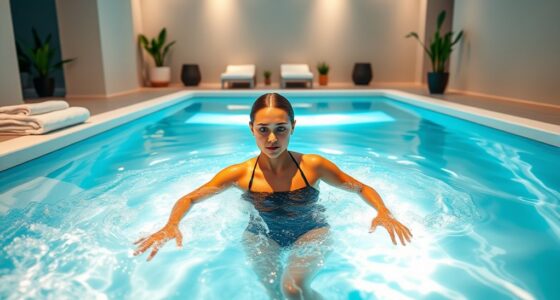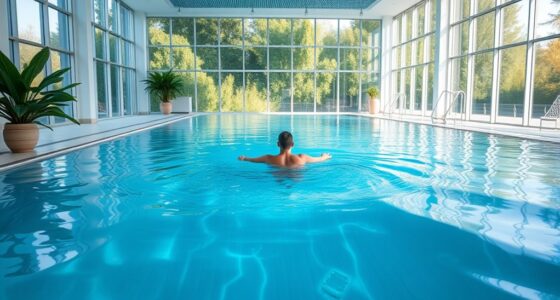Exercise pools provide an excellent way to achieve fitness goals right at home. The buoyancy reduces impact on joints, making workouts safer and more accessible. You’ll engage various muscle groups while enjoying the calming effects of water. Essential equipment like foam dumbbells and kickboards can enhance your routine. Aim for three to five workouts a week for best results. Keep exploring, and you’ll discover more about effective aquatic exercises and maintaining your pool.
Key Takeaways
- Exercise pools provide a low-impact environment, utilizing buoyancy to reduce joint strain while engaging all major muscle groups for effective workouts.
- Incorporate essential equipment like foam dumbbells and buoyancy belts to enhance your resistance training and overall workout experience in the pool.
- Aim for 3-5 pool workouts per week, combining swimming and water aerobics for optimal cardiovascular health and weight loss.
- Safety measures, such as exercising in shallow water and using flotation devices, are crucial to minimize risk of injury during workouts.
- Regular maintenance of your exercise pool ensures clean water quality and safe conditions for effective aquatic fitness sessions at home.
Benefits of Exercising in an Exercise Pool
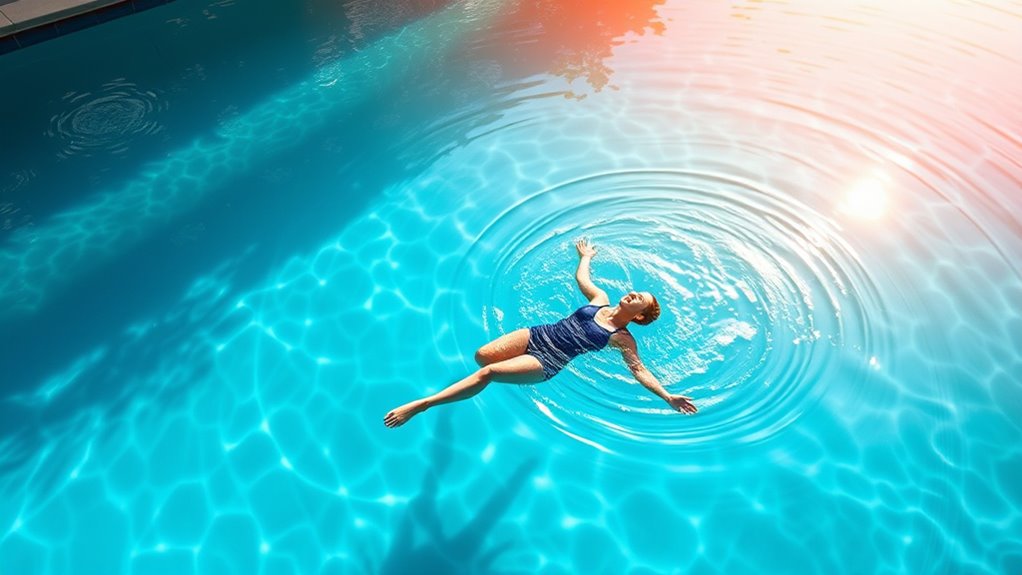
Exercising in an exercise pool offers numerous benefits, especially if you’re looking for a low-impact workout that still challenges your body.
The buoyancy of water reduces your weight by about 90%, making movement easier and allowing for a more intense full-body workout without the risk of falls. Aquatic exercise engages all muscle groups while minimizing strain on your joints, which is perfect if you have injuries or arthritis.
These water-based workouts not only promote weight loss but also enhance muscle toning and fat burning thanks to water’s natural resistance. Plus, regular use can improve your cardiovascular health, flexibility, and balance.
When combined with proper nutrition and hydration, you’ll experience significant improvements in overall health and fitness.
Essential Equipment for Your Pool Workouts

To maximize your pool workouts, having the right equipment can make a significant difference. Invest in essentials like a towel, swim cap, and goggles for comfort and visibility.
Consider using foam dumbbells to engage different muscle groups and enhance your strength training. Incorporate a pool noodle for support during exercises and to improve your balance.
If you’re looking to increase workout intensity, strap on ankle weights for added resistance. Buoyancy belts are great for beginners, providing stability while you perform cardiovascular exercises.
Verify the water temperature is comfortable so you can focus on your workouts without distraction. With the right gear, you’ll make the most of your aquatic fitness journey.
Health Benefits of Aquatic Exercises
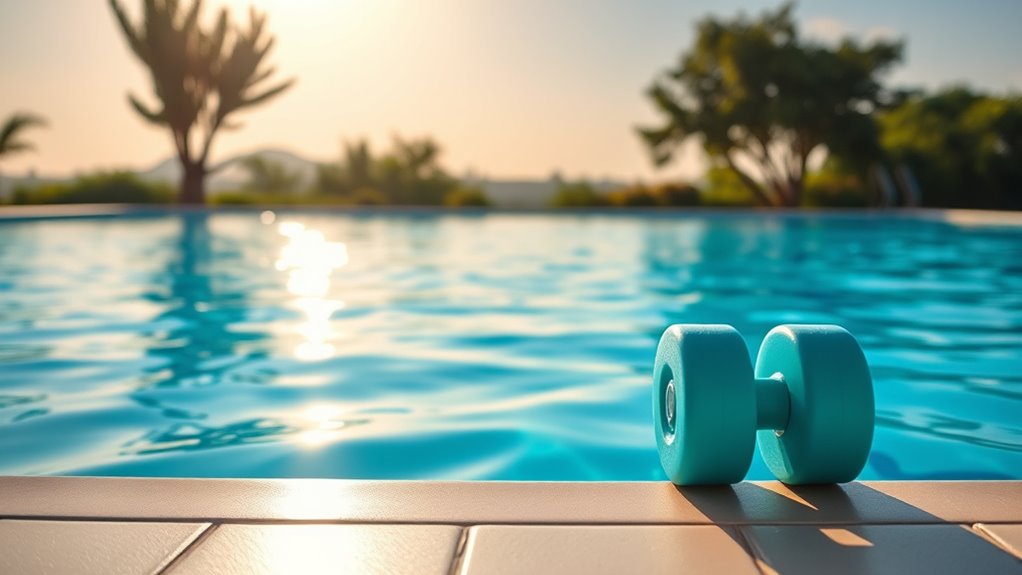
While many people seek effective ways to improve their fitness, aquatic exercises offer unique health benefits that set them apart from traditional workouts.
Pool exercises utilize the resistance of water, enhancing cardiovascular health while aiding in weight loss. The buoyancy reduces joint stress, making these workouts perfect for those with chronic conditions, arthritis, or recovering from injuries.
By engaging in water workouts, you can strengthen your core muscles, improve flexibility, and boost overall endurance. Regular participation considerably enhances mobility and quality of life for individuals facing health challenges.
Engaging in water workouts strengthens your core, enhances flexibility, and boosts endurance, significantly improving mobility and quality of life.
Plus, the supportive environment of water encourages you to enjoy your workouts, promoting mental well-being and consistent physical activity. Incorporating preventive care into your routine can lead to even greater long-term health benefits.
Immerse yourself in aquatic exercises for a healthier, happier you!
How Often Should You Work Out in Your Exercise Pool?
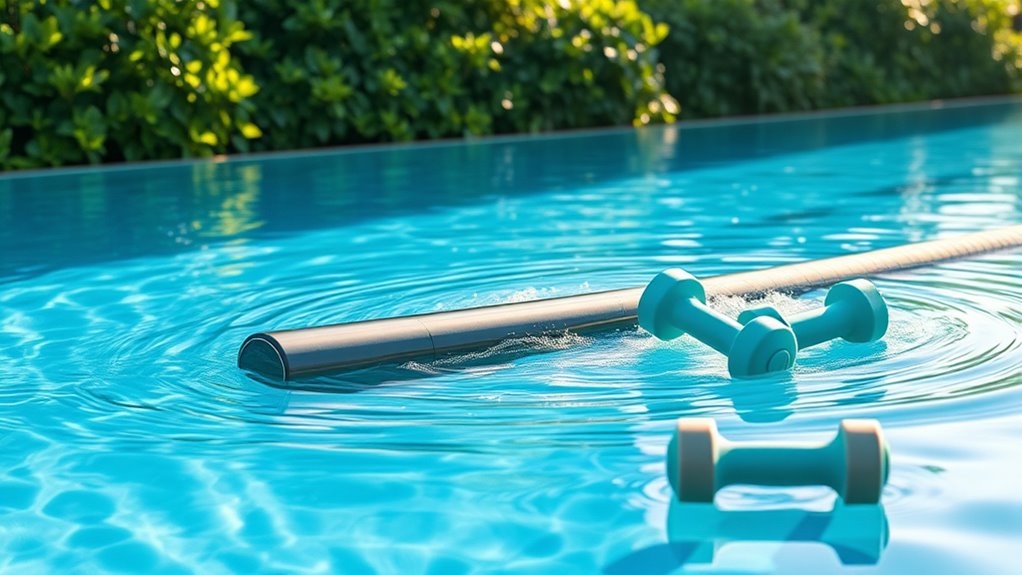
Finding the right frequency for your aquatic workouts can greatly impact your fitness journey. To effectively lose weight and enhance your overall health, aim to exercise in your at-home pool three to five times a week.
This exercise routine allows for a combination of lap swimming and resistance training, maximizing your fitness benefits. If you’re focusing on injury rehabilitation, working out twice a week can help you achieve recovery goals.
Remember to incorporate essential tips like waiting 2-4 hours post-meal for ideal comfort, or opting for lighter snacks for a shorter wait. Exercising just once a week may not yield significant improvements, so make sure to commit to a consistent schedule—your body will thank you!
Full-Body Pool Exercises to Try
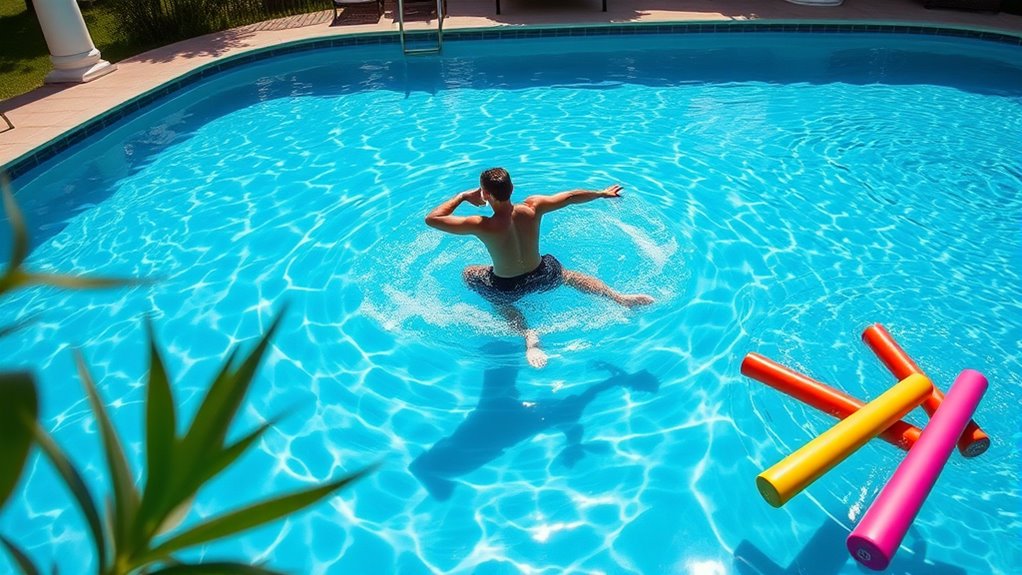
If you’re looking to engage your entire body while enjoying the benefits of water, aquatic exercises offer a fantastic way to achieve your fitness goals.
Here are some full-body pool exercises that are perfect for older adults and can easily be done in your exercise pool:
Discover full-body pool exercises ideal for older adults that can be easily performed in your exercise pool.
- Water walking: A low-impact way to boost cardiovascular fitness and strengthen lower body muscle groups.
- Lateral arm lifts: Use foam dumbbells for added resistance, targeting your arms and shoulders.
- Jumping jacks: Engage both upper and lower body muscles while improving coordination.
- Lunges: Side lunges enhance stability and lower body strength.
- Balance exercises: Standing on one leg challenges your stability and helps tone muscle groups.
These easy exercises make for an effective workout in the water!
Safety Tips for Exercising in Water
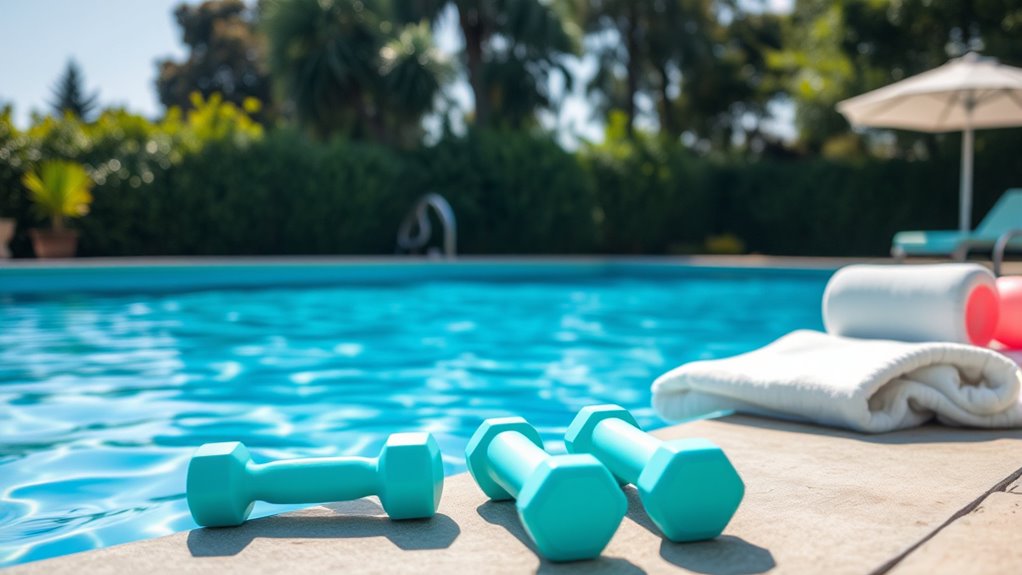
How can you guarantee a safe and effective workout in the water?
First, always exercise in shallow water to minimize injury risk, especially if you’re a beginner or have mobility issues.
It’s also essential to avoid swimming alone; having someone nearby assures help is available if needed.
If you experience dizziness, nausea, or chest pain, stop exercising immediately to protect your health.
Don’t forget about hydration—sweating in water may not be obvious, but staying hydrated is key for performance and safety.
If you’re a less confident swimmer or trying new exercises, consider using flotation devices to enhance your stability and balance.
Following these safety tips will help you enjoy your aquatic workout with peace of mind.
Incorporating Resistance Training in Your Pool Routine

Incorporating resistance training into your pool routine can greatly enhance your strength while reducing stress on your joints.
Using equipment like foam dumbbells or resistance gloves allows you to engage your muscles more effectively in the water.
With exercises such as underwater squats and arm lifts, you’ll not only tone your body but also boost your overall fitness.
Benefits of Resistance Training
While many people associate resistance training with land-based workouts, incorporating it into your pool routine can elevate your fitness game.
Aquatic resistance training offers unique benefits that enhance muscle strength and endurance while being gentle on your joints. Here are some advantages you’ll enjoy:
- 360-degree resistance from water enhances your workout intensity.
- Buoyancy supports your body, reducing stress on joints.
- Suitable for all fitness levels, it improves overall fitness outcomes. Engaging in this type of training can also help boost hydration, which is essential for optimal health benefits of juice cleansing. Additionally, engaging in resistance training can foster a growth mindset, enabling you to embrace new challenges in your fitness journey. Regular exercise can also contribute to reduced potential side effects from medications that may be necessary for other health conditions.
- It effectively tones muscles while supporting weight loss goals.
- Engaging and fun, it keeps you motivated to stay active. Additionally, you can store excess juice in airtight containers to maintain freshness, much like how maintaining hydration with proper water intake supports your fitness routine.
Effective Resistance Equipment Options
When you’re looking to elevate your aquatic workouts, choosing the right resistance equipment can make all the difference. Here are some effective options to enhance your pool routine:
| Equipment | Benefits |
|---|---|
| Resistance Gloves | Increase workout intensity and endurance |
| Foam Dumbbells | Target arm muscles using water buoyancy |
| Kickboards | Engage legs and core during lower body workouts |
| Ankle Weights | Provide extra resistance with low impact |
| Hydrodrive™ Current | Customize resistance to match your fitness goals |
Incorporating these tools not only boosts your strength but also makes your workouts more engaging and versatile. So, grab some resistance gloves or foam dumbbells and start maximizing your in-pool training today!
Swimming vs. Water Aerobics: Which Is Right for You?
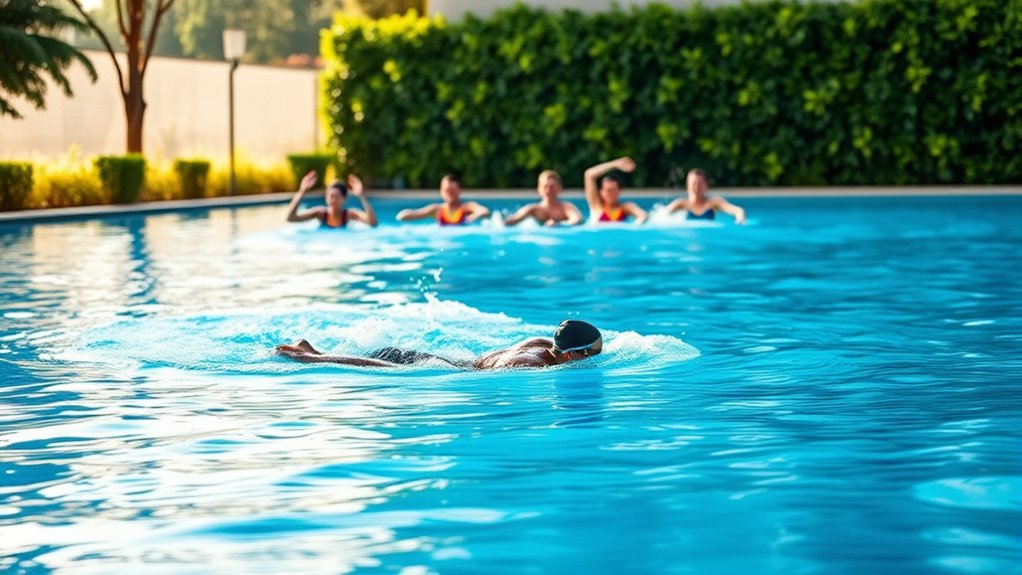
Are you wondering whether swimming or water aerobics is the better fit for your fitness journey? Both options offer unique benefits, so it’s important to evaluate your goals and preferences.
- Swimming is a low-impact exercise that engages your entire body, improving cardiovascular health.
- It boosts endurance and overall fitness levels considerably.
- Water aerobics focuses on resistance exercises that enhance strength and flexibility.
- This option is especially supportive for individuals with joint pain or mobility issues.
- Both activities are adaptable, allowing you to modify intensity and duration based on your needs.
- Engaging in aquatic fitness can also enhance your community resilience by promoting a supportive environment for health and well-being.
Ultimately, whether you choose swimming or water aerobics, you’ll enjoy effective aquatic fitness tailored to your lifestyle.
Tips for Getting Started With Pool Exercises
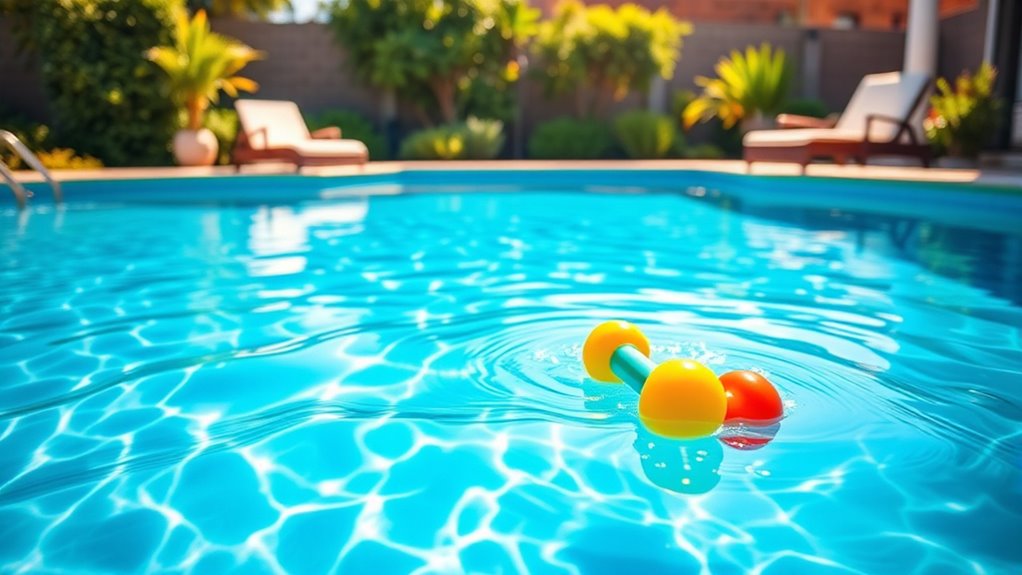
How can you get started with pool exercises effectively? First, consult with a physical therapist or healthcare provider to tailor your program to your specific needs.
Wear water shoes for traction and protection. Begin in waist- or chest-high water, where you can stay cool while working out. Start with water walking, keeping your arms at your sides, and gradually increase intensity.
Incorporate lunges and arm raises to target different muscle groups and break the monotony. Remember to hydrate; bring a water bottle, as you mightn’t notice sweating in the water.
Take breaks as needed to guarantee your safety and comfort. Over time, you’ll become more comfortable and can slowly lower the intensity to match your fitness level.
Maintaining Your Exercise Pool for Optimal Use

To maintain your exercise pool for ideal use, regular upkeep is essential, ensuring a safe and inviting environment for your workouts.
Here are some key maintenance tasks you should prioritize:
- Regularly check water quality by testing pH, chlorine, and alkalinity levels.
- Clean the pool surfaces and filters weekly to prevent algae growth.
- Monitor and adjust water temperature, keeping it between 78°F and 82°F.
- Inspect pool equipment like pumps and heaters for proper function.
- Schedule professional maintenance services occasionally for structural issues.
Frequently Asked Questions
What Exercise Burns the Most Belly Fat in the Pool?
You won’t believe it, but water jogging is the ultimate belly fat annihilator!
When you hit the pool and start jogging in that invigorating water, you’re torching calories like a superhero.
Combine that with high-intensity interval training, and you’ve got a recipe for success.
Don’t forget to swim laps and incorporate core exercises like water planks.
By doing this regularly, you’ll sculpt your midsection and feel fantastic!
Plunge in and get going!
How Many Times a Week Should You Do Water Aerobics?
You should aim to do water aerobics 3 to 5 times a week for ideal results in fat loss and weight management.
If you’re focusing on injury rehabilitation, twice a week may be enough for noticeable improvements in strength and mobility.
Remember, consistency is key!
Try to keep your sessions at least 30 minutes long, mixing aerobic and resistance exercises to enhance cardiovascular fitness, flexibility, and muscle tone over time.
Can You Lose Weight Doing Water Aerobics?
Imagine diving into a sea of fitness, where every splash carries away your worries and pounds. Yes, you can lose weight doing water aerobics!
This low-impact workout torches 400 to 500 calories per hour, depending on your intensity and weight. The buoyancy of water eases joint stress, letting you push harder without injury.
What Is the Best Aquatic Exercise?
The best aquatic exercise really depends on your fitness goals, but water walking is a fantastic starting point. It improves leg muscle mass effectively while being gentle on your joints.
For a full-body workout, try jumping jacks or lunges in the pool; they engage multiple muscle groups and enhance strength.
Don’t forget to incorporate resistance training with foam dumbbells or paddles to build endurance. You’ll enjoy the benefits while having fun in the water!
Conclusion
As you immerse yourself in your exercise pool journey, you’ll discover the perfect blend of fitness and fun. Coincidentally, embracing aquatic workouts not only boosts your physical health but also uplifts your mood, as the soothing water surrounds you. Whether you’re splashing through full-body exercises or enjoying resistance training, you’ll find that consistency is key. So, take the plunge, stay committed, and watch how your exercise pool transforms your fitness routine into a revitalizing escape.


